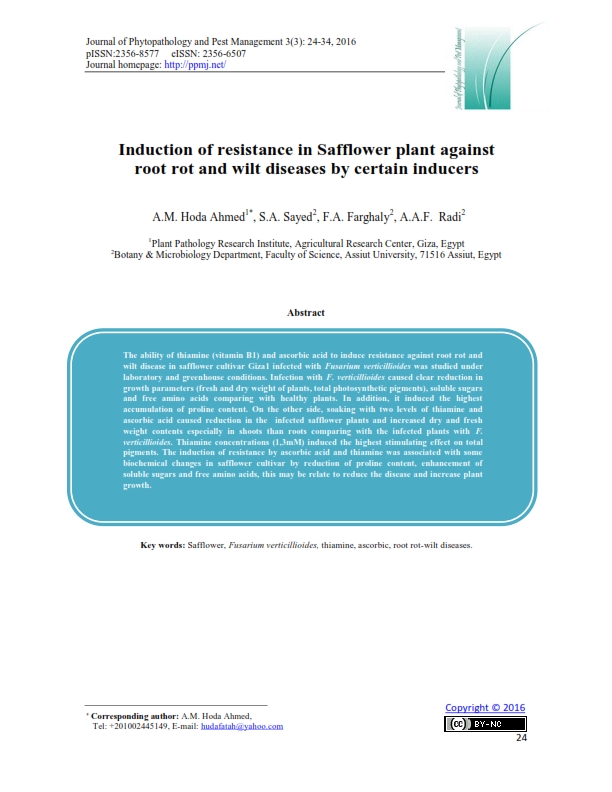Induction of resistance in Safflower plant against root rot and wilt diseases by certain inducers
Keywords:
Safflower, Fusarium verticillioides, thiamine, ascorbic, root rot-wilt diseases.Abstract
The ability of thiamine (vitamin B1) and ascorbic acid to induce resistance against root rot and wilt disease in safflower cultivar Giza1 infected with Fusarium verticillioides was studied under laboratory and greenhouse conditions. Infection with F. verticillioides caused clear reduction in growth parameters (fresh and dry weight of plants, total photosynthetic pigments), soluble sugars and free amino acids comparing with healthy plants. In addition, it induced the highest accumulation of proline content. On the other side, soaking with two levels of thiamine and ascorbic acid caused reduction in the infected safflower plants and increased dry and fresh weight contents especially in shoots than roots comparing with the infected plants with F. verticillioides. Thiamine concentrations (1,3mM) induced the highest stimulating effect on total pigments. The induction of resistance by ascorbic acid and thiamine was associated with some biochemical changes in safflower cultivar by reduction of proline content, enhancement of soluble sugars and free amino acids, this may be relate to reduce the disease and increase plant growth. Â
Metrics

Published
How to Cite
Issue
Section
License
Authors who publish with Journal of Phytopathology and Disease Management agree to the following terms:
- Authors retain copyright and grant the journal right of first publication with the work simultaneously licensed under a Creative Commons Attribution License that allows others to share the work with an acknowledgement of the work's authorship and initial publication in this journal.
- Authors retain copyright and grant the journal right of first publication with the work simultaneously licensed under the Creative Commons Attribution-Non Commercial License (CC BY-NC). This allows others to share the work with an acknowledgement of the work's authorship and initial publication in this journal.
- Archives of Agricultural Sciences Journal is an Open Access Journal, and articles published are distributed under the terms of the Creative Commons Attribution-Non Commercial License (CC BY-NC). Readers may copy, distribute, and display the work for non commercial purposes with the proper citation of the original work. However, the journal retains the right to exploit subsidiary rights on behalf of the authors.
- Authors are able to enter into separate, additional contractural arrangements for the non-exclusive distribution of the journal's published version of the work (e.g. post it to an institutional repository or publish it in a book), with an acknowledgement of its initial publication in this journal.
- Authors are permitted and encouraged to post their work online (e.g., in institutional repositories or on their website) prior to and during the submission process with full disclosure to the journal, as it can lead to productive exchanges, as well as earlier and greater citation of published work. Following publication in Archives of Agricultural Sciences Journal, the author should update the repository, and include a citation and link to the published work.
Click here for more information on Licensing policy
.png)




